牛津英语上海版四年级下册M2U2 备课教案
牛津上海版四下《Unit 2 My toys》word教案1

M2U 2 My toys< 1 > ( )Teaching aimsBasic aims1.To learn cardinal numbers: twenty-one --- fifty2.To learn the words: mask, soldier, puzzle. Developing aimsing nouns to identify things.ing numerals to describe quantity.Important points:1.To learn cardinal numbers: twenty-one --- fifty2.To learn the words: mask, soldier, puzzleDifficult points:ing nouns to identify things.ing numerals to describe quantity.Teaching aids Cassette player, word and picture cardsProcedures:Pre-task presentation:Review numbers.While-task procedure:1. Introduce: forty, fifty by referring to the Arabic numbers and words on the wallpicture.2. Play the cassette.3.Write the Arabic numbers: 31—39,and 41—49 on the board.4.Review: dolls, balls, bears, robots, cars, aeroplanes, boats by inviting students to make simple drawing on the board.Introduce: masks, soldiers, puzzles …5.Ask S to count the toys and write the number in words above the illustrations.6. Divide the class into groups. Play the games.7. Ask S to put the small objects they have brought to class on their desks.8.Tell each group to ask for the record sheet from the group which the bag originally belong to SPost-task activity1. Distribute a copy of Photocopiable P20 to each other.2. Get students to colour the insects and animals individually according to the sentences.Homework板书设计21 twenty-one 30 thirty40 forty 50 fiftyHow many /much .…?M2U2 My toys< 2 > ( )Teaching aimsBasic aims1.To learn ‘Wh’ questions:How many … are there?How much … are …?2. To learn the demonstratives: these, those3.To learn the sound ‘-sk’Developing aimsing nouns to refer to more than one object.ing numerals to describe quantity.Important points:1.To learn ‘Wh’ questions2.To learn the demonstratives: these, thoseDifficult points:How many … are there?How much … are …?Teaching aids Cassette 4B, cassette playerProcedures:Pre-task presentation:Invite five S to come to the board. Ask them to draw as many apples as they can. While-task procedure:1.Ask: How many apples are there?2.Ask S to draw and count different objects.3.Draw a doll with a price on the board.Ask: How much is it?4.Draw various objects of different quantities on the board. Ask S to work in pairs.5.Have students look at the picture on page 23 of the student’s Book again. Invite a student to read the dialogue.6.Invite pairs of students to read the dialogue to the class.Post-task activityLearn the sound.1. Play the cassette.2. Play the cassette again.3. Invite individual students to read the sentence.HomeworkAsk S to count each toy and write down the number beside each of them.板书设计Read and answerHow many …?How much …?M2U2 My toys< 3 > ( )Teaching aimsBasic aimsing nouns to identify things . eg : bedrooming the present continous tense to describe an action taking place at thetime of speaking .eg : I’m doing a puzzle / making a doll.Developing aimsOpen an interaction by eliciting a responseImportant points:Using the present continous tense to describe an action taking place at the time of speaking .eg : I’m doing a puzzle / making a doll.Difficult points:Using the phrases : doning a puzzle / making a doll/washing toys .Teaching aids cassette , picturesProcedures:Pre-task presentation:1.Show Ss pictures of bedroom,bathroom,kitchen, dining-room and sitting –roomcollected from the magazines .2.Mix up the pictures . Invite a few students to group the pictures and stickthem on the board.While-task procedure:1.Introduce:bedroom,bathroom,kitchen,sitting-room and dining-room with the pictures .2 2.Say bedroom,bathroom,kitchen,sitting-room and dining-room and have studentsrepeat after you .3.Take away the magazine pictures on the board .Put the picture cards on thedesk .Invite individual students to match the picture cards with the word cards .4.Play the cassette .Studets listen and follow in their books .5.Play the cassette again . Studets listen and repeat.6.Play the cassette for the third time . Students listen and look at the fivestatements in True or falseStudents write true or false .7. Invite individual students to read the true statements.Post-task activity1.Encourage students to rewrite the false statements to make them true .2.Divide students into groups .Ask each group to prepare to act the story .Homework1.Look at the pictures and decribe them in English.plete the workbook .Where are you?What are you doing ?I’m making an aeroplaneI’m doing a puzzle .M2U 2 My toys< 4 > ( )Teaching aimsBasic aims1.To learn the ‘Wh’ questions: Where are … and …?/ What is that?2.To learn the words: moon, restaurant, rock,3.To learn demonstratives: this, that, these, thoseDeveloping aimsing nouns to identify places.2.Asking ’Wh’ questions to find out specific information about a person. Education aims:To educate the children to love science.Important points:1. To learn the ‘Wh’ questions:2.To learn the words: moon, restaurant, rock,3.To learn demonstratives: this, that, these, thoseDifficult points:This/That is …… These / Those are……Teaching aids Cassette, word and picture cardsProcedures:Pre-task presentation:Tell students listen to a story about Supergirl and Superdog on the moon. Stick the word and picture on the board.While-task procedure:1. Play the cassette.2.Ask S to compare the story that they have just heard with the one they had thought.3.Play the cassette again.4.Invite pairs of students to read and answer questions.5. Encourage S to add more details when they prepare the play.6. Invite pairs of S to act out the story in front of the class.Post-task activity1. Divide students into groups. Distribute drawing paper to each group.2.Ask each group to think of a new story about supergirl and superdog. HomeworkRemind students to design a cover and a poster.Read a storyspaceship on the moon。
四年级英语下册 Module2 Unit2 period2教案 沪教牛津版
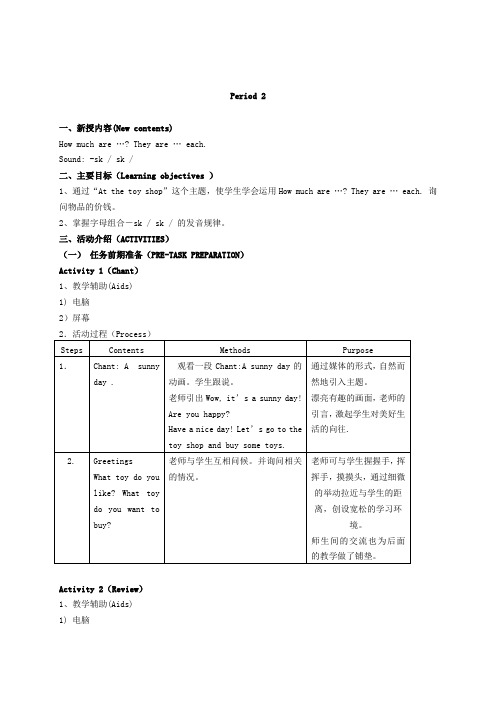
Period 2一、新授内容(New contents)How much are …? They are … each.Sound: -sk / sk /二、主要目标(Learning objectives )1、通过“At the toy shop”这个主题,使学生学会运用How much are …? They are … each. 询问物品的价钱。
2、掌握字母组合-sk / sk / 的发音规律。
三、活动介绍(ACTIVITIES)(一)任务前期准备(PRE-TASK PREPARATION)Activity 1(Chant)1、教学辅助(Aids)1) 电脑2)屏幕2.活动过程(Process)Activity 2(Review)1、教学辅助(Aids)1) 电脑2)屏幕(二)任务实施过程(WHILE-TASK PROCEDURE)Activity 1 (Talk about the price)1、教学辅助(Aids)1) 电脑2)屏幕Activity 2 (New patterns)1、教学辅助(Aids)1) 电脑2) 屏幕经过机械性操练,学生对新学句型的语音语义有了一定的感知,下面在教师的引导下通过意义性操练,使学生逐步学会运用所学的句型,体会所学的句型的运用的语言环境,并逐步达到能认读和书写。
Activity 3 ( passing game ) 1、教学辅助(Aids) 1) 图片 2) 电脑 3) 屏幕Activity 4 (Guessing game ) 1、教学辅助(Aids) 1) 电脑 2) 屏幕2.活动过程(Process )Activity 5 (Say and act)1、教学辅助(Aids)1) 电脑2) 屏幕2.活动过程(Process)Activity 6 (Learn the sound )1、教学辅助(Aids)1) 电脑2) 屏幕(三)任务后期活动(POST-TASK ACTIVITY)在这个环节中教师将为学生创设贴近生活的语言环境,让学生充分利用所学知识进行交际。
牛津英语4下cute animal教案
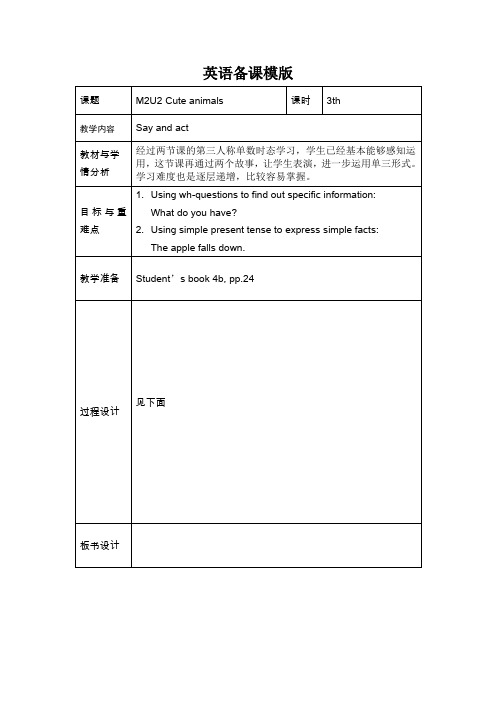
\
He/She is _____and ______.
He /She has____ and______.
He/She likes __________.
呈现故事1,让学生表演。(强调it smells nice的单三形式)
Repeat the story and act it.
学习活:1:
同桌讨论后说说自己对友谊的看法。
Step 1
and revision
播放儿歌:the more we get together
Sing the song together
组织头脑风暴,复习食物的单词
说出食物的相关单词
Step 2
Presentation
and practice
让学生通过min的口吻描述mog:_______ is my friend.
He is ______ and______.
He has_________ andFill in the blank, then read it
Pair: talk about your friends
________ is my friend.
What do you have?
ing simple present tense to express simple facts:
The apple falls down.
教学准备
Student’s book 4b, pp.24
过程设计
见下面
板书设计
教学反思
教学结构
教师行为
学生行为
设计意图
英语备课模版
课题
M2U2 Cute animals
牛津沪教四下Module2《Unit1Mypet》word教案
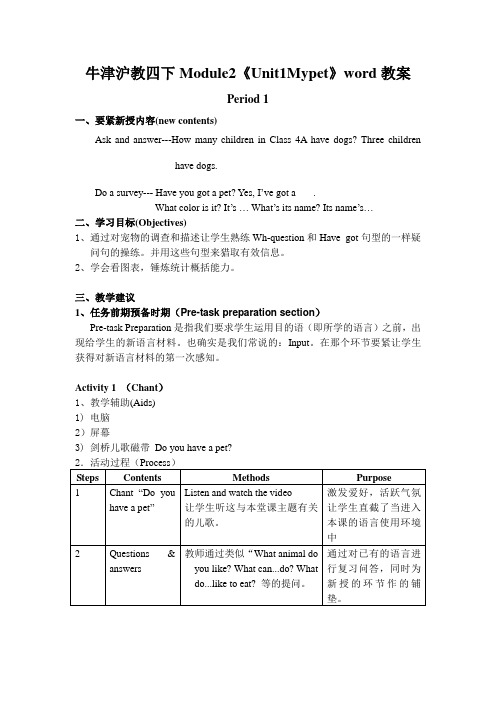
牛津沪教四下Module2《Unit1Mypet》word教案Period 1一、要紧新授内容(new contents)Ask and answer---How many children in Class 4A have dogs? Three childrenhave dogs.Do a survey--- Have you got a pet? Yes, I’ve got a ___.What color is it? It’s … What’s its name? Its name’s…二、学习目标(Objectives)1、通过对宠物的调查和描述让学生熟练Wh-question和Have got句型的一样疑问句的操练。
并用这些句型来猎取有效信息。
2、学会看图表,锤炼统计概括能力。
三、教学建议1、任务前期预备时期(Pre-task preparation section)Pre-task Preparation是指我们要求学生运用目的语(即所学的语言)之前,出现给学生的新语言材料。
也确实是我们常说的:Input。
在那个环节要紧让学生获得对新语言材料的第一次感知。
Activity 1 (Chant)1、教学辅助(Aids)1) 电脑2)屏幕3) 剑桥儿歌磁带Do you have a pet?Activity 2 Song1、教学辅助(Aids)1) 电脑2)屏幕2、任务中期实施时期(While-task procedure section)While-task Procedure,这是指语言技能的习得过程。
其中分为机械性操练和意义性操练两部分。
机械性操练能够让学生准确地仿照、复说新授的语言,让他们通过从仿照到识记的过程,使新知识由感知、明白得、仿照直到储存。
通过不同形式的教学活动,保持学生的学习爱好。
Activity 1 Pass it on1、教学辅助(Aids)1) 电脑2)录音机Activity 2 (Pair work)1、教学辅助(Aids)图片录音机完成比较扎实的机械性操练,就进入了意义性操练时期。
【教育学习文章】上海牛津版四年级英语下册Unit 2 What can you hear-教案

上海牛津版四年级英语下册Unit 2 What can you hear?教案Unit2whatcanyouhear?Languageskills:Listening:Identi fykeywordsinanutterancebyrecognizingthestressLocate specificinformationinresponsetosimplequestionsSpeak ing:openaninteractionbyelicitingaresponsemaintainan interactionbyprovidinginformationinresponseUseappro priateintonationinquestionsandstatementswriting:Dev elopwrittentextsbyaddingpersonalideasandinformation towritingDevelopwrittentextsbyputtingwordsinalogica lordertomalemeaningfulphrasesorsentencesDifficultpo ints:Prepositions:Behind,beside,in,on,under‘wh-’question:where\what\whose…?materials:Pictures,reco rder,tapesTeachingTimes:FiveperiodsFirstperiodcontents:words:piano,recorder,violin,guitar,drum,triangleLanguagefocus:Usingnoun stoidentifythingse.g.apianoDifficultpoints:Pronunci ation:piano,recorder,violin,guitar,drum,triangleTea chingbreach:Usingthesongstopracticethewords.Procedu recontentsmethodPurposePre-taskpreparation1.Song2.Dailytalk3.RevisionPssingtogetherT-PP-Pwhile-taskprocedureLookandlearnwhatcanyouplay?Icanplay…T:Look.what’stheshape?P:It’satriangle.Psay‘triangle’T:Look,Icanplaythetriangle.Ting…PsayandactT:Ihavegotadrum.It’snice.Pread‘drum’P:Icanplaythedrum.Boom…T:whosepenisthat?Thesamewaytoteach;piano,recorder.V iolin,guitarT:Icanplaythe…whatcanyouplay?PanswerP-PSingasongtogether在词汇的教学中注重单词发音的体会,帮助学生根据发音规律来记忆单词。
小学四年级英语上海牛津版四年级英语下册Module2Myfavouritethings教学设计
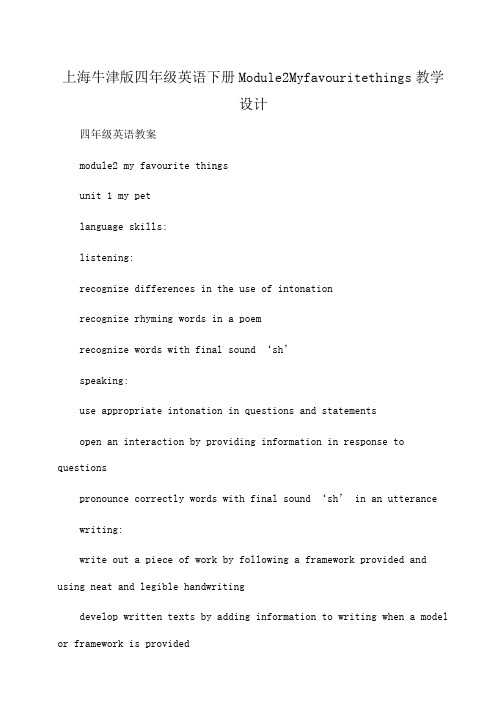
上海牛津版四年级英语下册Module2Myfavouritethings教学设计四年级英语教案module2 my favourite thingsunit 1 my petlanguage skills:listening:recognize differences in the use of intonationrecognize rhyming words in a poemrecognize words with final sound ‘sh’speaking:use appropriate intonation in questions and statementsopen an interaction by providing information in response to questionspronounce correctly words with final sound ‘sh’ in an utterance writing:write out a piece of work by following a framework provided and using neat and legible handwritingdevelop written texts by adding information to writing when a model or framework is provideddifficult points:countable noun: petcountable nouns (animals)‘wh-‘ questions: what colour is it? who’s…? what’s its name?materials: pictures, recorder, tapesteaching times: five periodsfirst periodcontents:read a poem, do a surveylanguage focus:asking ‘wh-‘ questions to find out various kinds of information about an animalasking ‘yes/no’questions to find out a person’s possessionsdifficult points:read a poem,do a surveyteaching breach: using the cassette to listen and act.materials: pictures of animals ,story, recorder procedurecontentsmethodpurposepre-taskpreparation1. song2. daily talk3. revisionps sing togethert-pt show some animals,ask questions about the animals p answer通过唱歌调动气氛。
上海牛津英语四年级下册Module2Unit2Mytoys5课时英文表格式教案.docx

Unit 2 My toysLanguage skills:Listening:Identify key words in an utterance by recognizing the stressRecog nize d iff ere nces in the use of inton at io n to d if fere ntiate betwee n questions and statements and respond appropriatelyLocate specific information in response to simple questionsRecog nize words with fin al soun d'・sk'Reading:Locate specific information in a short text in response to questions Recog nize familiar words in un familiar con textsSpeaking:Use modeled phrases and sentences to communicate with other LearnersUse appropriate intonation in questions and statementsOpen an in teraction by eliciting a resp onsePronounce correctly words with final sound '・sk' in an utteranceMaintai n an in teract i on by providi ng informatio n in response to factual questi onsWriting:Revise and edit short written texts by making changes to incorrect Information Develop written texts by writing a first draftDifficult points:Present continuous tense’How' questions:How many…are there?Materials:Word and picture cards, ol)jects, cassette and a cassette player Workbook 4BTeaching times:Five periodsFirst PeriodCon tents:Look and learn丄ook and sayLanguage focus:Using nouns to refer to more than one objectiveUsing nouns to identify thingsUsing numbers to describe quantifyDifficult points:New words: soldier, boat, puzzle, thirty, fortyTeaching breach: Using the toys to ask and answer.ProcedureContents MethodPurposePre-task preparation I.Song2. Daily talk3. Revisi onPs sing togetherT-POn e-tenP say and hold up their fin gers P・P work in pairseleve n・twentyWhile-task procedure twenty-on e—twe nty・nine 一・thirty fortyfiftyLook and sayPlay a gameT introduce twenty-one to thirtyP readT introduce forty-ninetyP readT introduce hundred, thousand,millionP learn, T tapeT show Wallpicture:Whafs in the shop?P bears/dolls...T introduce: soldier, boat, puzzleP read, make phrases with thesewordsP count the toys and write thenumber in words above theillustrati ons toy—bag game通过各种形式的操练,培养学生正确拼读单词。
上海版牛津英语四年级下册4BModule2Unit2Mytoys4课时教案教学设计.docx

Unit 2 My toysTeaching Contents: P23—P26Teaching Aims:1.Learners tell the price and the name of the toys in the picture2.Learners count and talk about the number of each type of toy in the toy shop3.Learners set up a toy shop in class and use shopping language to obtain toys theylike4.Learners read the story about the Li family and decide if the statements aboutthe story are true or false5.Learners guess what the characters are doing in the picture6.Learners read and role play the story about Supergirl on the moon Teaching Focus:Counting from 21 to 50Talking about money and the price of objectsAsking and describing where people are and what they are doingComprehend!ng simple narrativesSayi ng the sou nd z sk zTeaching Time: 4 periodsPeriod 1Teaching Contents: P23Teaching Aims:Learners tell the price and the name of the toys in the pictureLearners count and talk about the number of each type of toy in the toy shop Language focus:Using nouns to refer to more than one objecte.g. bearsUsing nouns to identify thingse.g. maskUsing numerals to describe quantitye.g. twenty・oneTeaching type : newMaterials:Student's Book 4B page 23Cassette 4B and a cassette playerPhotocopiable page 20Word and Picture Cards : soldiers, masksWallpicture : Count the toysPlastic bagsPreparation :Make copies of photocopiable page 20 for each student. Bring plastic bags .Pre-task preparationReview : one to ten by aski ng the stude nts to hold up their fin gers . Say : Five • Students hold up five fingers • Students then work in pairs to review : eleven to twenty.While-task procedure1.Introduce : twenty-one to thirty by pointing to the Arabic numbers and the words inpairs on the Wallpicture . For less able students , draw some apples on the board and count with the students when you introduce each number.2.Introduce : forty ,fifty by referring to the Arabic numbers and words (in pairs ) on theWallpicture .3.Play the cassette : Look and learn . Students listen and follow in their books .4.Play the cassette again • Students listen and repeat.5.Write the Arabic numbers : 31 to 39 and 41 to 49 on the board •Encouragestudents to write the numbers in words on the board to match with the Arabic numbers . For less able students , ask them to refer to the formation of 21 to 29 in words on page 23 of the student/s book as examples .6.Review : dolls , balls , bears , robots , cars , aeroplanes , boats by inviting students tomake simple drawings on the board . Introduce : masks , soldiers , puzzles using the pictures in Look and say • Tell students that though there is only one mask in the picture , it is correct to have masks on the price tag . The mask in the picturerepresents all that kind of mask in the toy shop . Explain for dolls , robots , boats , balls and aeroplanes as well.7.Ask students to count the toys and write the numbers in words above theillustrations.8.Divide the class into groups . Play the toy-bag game .9.Ask students to put the small objects they have brought to class on their desks . Haveeach group put a variety of the small objects , e.g. rubbers , pencils , rulers , buttons , wrapped sweets , marbles , etc. into the bag . The amount in each should be less than fifty and different for each group • Ask students to record the contents of each bag on a piece of paper •10・ Exchange the bags between groups . Students then work in their groups to put the various objects on a desk , group them and c ount them • Ask students to write down the answers on a piece of paper.Tell each group to ask for the record sheet from the group which the bag originally belonged to . Students check the answers .12. Students count the objects again if the amount on the answer sheet doesn't match thaton the record sheet.Post-task activityCount and writea.Distribute a copy of photocopiable page 20 to each student.b.Ask stude nts to count the in sects and an imals in the picture and write the numbersof each in the table •c.Students work in pairs to check answers .d.Students stay in pairs to discuss the colouri ng of the in sects and animals . Studentsthen fill in the blanks •e.Get stude nts to colour the in sects and animals in dividually according to the sentences at the bottom of their tasksheet • Remi nd students not to look at other's work when they do the colouring •f.Students exchange their and check the colouring . For less able students , tell them tocircle a certain animal /insect of a certain colour when they are counting. ConsolidationAt this stage Grammar Practice Book 4 B ,page 20 could be used to practice and consolidate the oral and written language in this section further.SummarizePeriod 2Teaching Contents: P24Teaching Aims:Learners set up a toy shop in class and use shopping Ianguage to obtain toys they like Language focus:Using nouns to refer to more than one objecte.g. puzzlesUsing numerals to describe quantitye.g. They're forty-six yuan •Asking z How z questions to find out the pricee.g. How much is it ?Using demonstratives to refer to thingse.g. How much are these puzzles ?Teaching type : newMaterials:Student's Book 4B page 24Cassette 4B and a cassette playerWorkbook 4B page 13Preparation :Ask students to bring some soft toys (optional)Pre-task preparationInvite five students to come to the board ・Ask them to draw as many apples as they can in five seconds • Count the apples with the students • Write : _____________ apples on the board •While-task procedure1.Write : How many apples are there ? There are __________ apples ・on the board .Count the apples with the students . Ask :How many apples are there ? to elicit: There are _____________ apples . Continue the game by asking students to draw andcount d iff ere nt objects .2.Ask students to look at the picture in Look and say on page 23 of the student'sbook • Ask :How many ____________ a re there ? to elicit : There are_________ (Students have counted the number of each toy in the previous lesson )3.Draw a doll with a price tag on the board • Introduce : How much is it ? It z s yuan .4.Draw a few apples on the board • Add a card with ¥5 on it in front of the apples •Introduce : How much are these apples ? to elicit : They're five yuan each . Tellstudents that it means five yuan each by pointing at each apple and saying : How much is it ? It z s five yuan • After pointing at the last apple , circle all the apples and say : They're five yuan each .5.Draw various objects of different quantities on the board . Review : these and thoseby standing close or staying away from the pictures on the board when you ask the questions •6.Have students look at the picture on page 23 of the student〃s book again. Invite astudent to read the dialogue with you . You read Ben's part and the student acts as the shop assistant and reads Jack's part.7.Students work in pairs to read the dialogue in Say and act . Remind students to payattention to where Ben is standing in the picture and decide on whether these or those should be used as the determiner in the question •8.Draw a picture similar to the one in Look and say on page 23 of the student's book on the board . Change the positions of the toys • Students exchange their roles an dread the dialogue again •9.Invite pairs of students to read the dialogue to the class • For more able students ,ask them to use their own soft toys when they do the role-play .Learn the sound1.Play the cassette . Students listen and follow in their books.2.Play the cassette again • Students listen and repeat.3.In vite in dividual stude nts to read the sentence .Post-task activityWorkbook page 13a.Ask students to count each toy and write down the number beside each of them .b.Students work in pairs to check the answers .c.Students stay in pairs to ask and answer the questions .d.Students fill in the blanks to complete the exercise •e.Invite pairs of students to ask and answer the questions .f.The rest of the class check answers .ConsolidationAt this stage Grammar Practice Book 4B ,page 21 could be used to practice and consolidate the oral and written language in this section further.SummarizePeriod 3Teaching Contents: P25Teaching Aims:Learners read the story about the Li family and decide if the statements about the story are true or falseLearners guess what the characters are doing in the pictureLanguage focus:Using nouns to identify thingse.g. bedroomUsing present continuous tense to describe an action taking place at the time of speaki nge.g. Km doing a puzzle .Aski ng z Wh- 'questi ons to find out specific in formation about a pers one.g. What are you doing ?Teaching type : newMaterials:Student's Book 4B page 25Cassette 4B and a cassette playerWorkbook 4B page 14Word and Picture Cards : bedroom , sitting-room , kitchen , bathroom , dining-room Pictures of bedrooms , sitting-rooms , kitchens , bathrooms , dining-rooms from magazines.Preparation :Collect pictures of bedrooms ,sitting-rooms ,kitchens ,bathrooms , dining-rooms from magazi nes.Pre-task preparationShow students pictures of bedrooms ,bathrooms , kitchens , dining-rooms and sitting-rooms collected from the magazines .Mix up the pictures . Invite a few students to group the pictures and stick them on the board .While-task procedure1.Introduce : bedroom ,bathroom ,kitchen ,sitting-room and dining-room using thepictures on the board .Stick the Word Cards beside t he pictures on the board •2.Say : bedroom ,bathroom ,kitchen ,sitting-room and dining-room and have studentsrepeat after you .3.Take away the magazine pictures on the board .Put the Picture Cards on your desk .Invite individual students to match the Picture Cards with the Word Cards on the board .4.Play the cassette : Read and answer. Students listen and follow in their books •5.Play the cassette again ・Students listen and repeat.6.Play the cassette for the third time . Students listen and look at the five statements inTrue and false . Students write True statements and false for all the false statements.7.In vite in dividual stude nts to read the new statements .8.For more able students , encourage them to rewrite the false statements to makethem true • For example , change Gra ndma is singing in the dinin g-room .intoGrandma is making a doll in the dining-room .9.In vite in dividual stude nts to write the new stateme nts on the board •10.Divide students into groups • Ask each group to prepare to act the story .11.Groups take turns to act the story in front of the class .Post-task activityWorkbook page 14a.Tell students that Miss Li is standing at the top of the staircase and she is looking forthe other characters .b.Have students find out where the characters a re and fill in the box in each picture •c.Students work in pairs to complete the dialogues orally .d.Students fill in the blanks to complete the dialogues .e.Invite pairs of students to read the dialogues. The rest of the class check the answers.ConsolidationAt this stage Grammar Practice Book 4B ,page 22 could be used to practice and consolidate the oral and written language in this section further.SummarizePeriod 4Teaching Contents: P26Teaching Aims:Learners read and role play the story about Supergirl on the moonLanguage focus:Using nouns to identify placese.g. a restaura ntAski ng z Wh J questions to find out specific in formation about a pers on e.g. What does Supergirl /Superdog like ?Teaching type : newMaterials:Student's Book 4B page 26Cassette 4B and a cassette playerWord and Picture Cards : rocks, mountain , restaura ntDrawing paperPreparation:Bring drawing paper.Pre-task preparationStudents have their books closed • Ask students if they remember Supergirl and Superdog .Tell students they are going to listen to a story about Supergirl and Superdog on the moon • Stick the Word and Picture Cards : rocks , mountain , restaura nt on the board as cluestroduce the new words .Don't disclose the story in detail at the moment . Encourage students to guess what the story will be about•While-task procedure1.Play the cassette : Read a story . Students listen •2.Ask students to compare the story that they have just heard with the one they hadthought of. Ask : Are they the same or different ?3.Play the cassette again • Students listen and follow in their books •4.Play the cassette for the third time . Students listen and repeat.5.Students work in pairs to answer the questions in Point ,ask and answer . For some ofthe pictures , students are required to point to a certain character on a certain object when they ask the questions .6.Invite pairs of students to read and answer the questions •7.Students stay in pairs and practice acting the story .8.For more able students , encourage them to add more details when they prepare theplay •9.Invite pairs of students to act the story in front of the class •10.Students vote for the best group .Post-task activityA collect!on of Supergirl and Superdog's storiesa.Divide students into groups • Distribute drawing paper to each group .b.Ask each group to think of a new story about Supergirl and Superdog .c.Students discuss and decide on their different responsibilities .d.Students start drawing ,painting and writing .e.Remi nd students to desig n a cover and a poster.f.Con duct a small book fair in the class .ConsolidationOxford English Practice and Assessment Series 4B part 1, Module 2 , Unit 1 presents further grammar and vocabulary exercises as well as listening and reading skills development tasks •SummarizeThe students are very interested in the story "Supergirl on the moon “」ask them to learn the text by themselves . And invite them to answer the questions at the bottom of the page .Some of them can answer the question ,but they will make a few mistakes・。
四年级英语下册 Module2 Unit2 period3教案 沪教牛津版
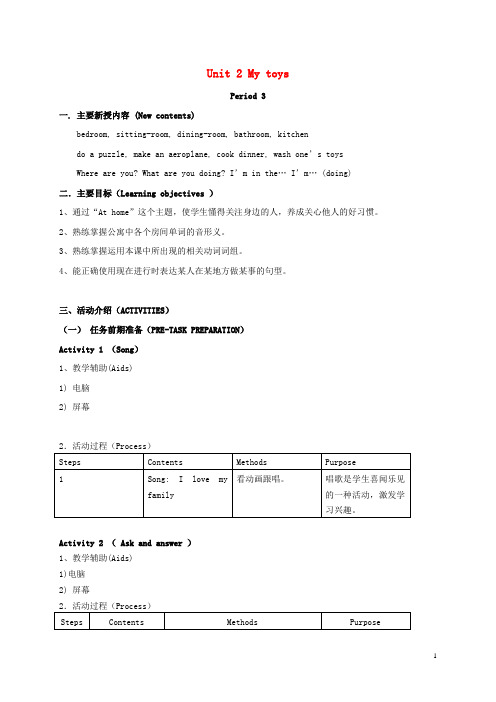
Unit 2 My toysPeriod 3一. 主要新授内容 (New contents)bedroom, sitting-room, dining-room, bathroom, kitchendo a puzzle, make an aeroplane, cook dinne r, wash one’s toysWhere are you? What are you doing? I’m in the… I’m… (doing)二.主要目标(Learning objectives )1、通过“At home”这个主题,使学生懂得关注身边的人,养成关心他人的好习惯。
2、熟练掌握公寓中各个房间单词的音形义。
3、熟练掌握运用本课中所出现的相关动词词组。
4、能正确使用现在进行时表达某人在某地方做某事的句型。
三、活动介绍(ACTIVITIES)(一)任务前期准备(PRE-TASK PREPARATION)Activity 1 (Song)1、教学辅助(Aids)1) 电脑2) 屏幕Activity 2 ( Ask and answer )1、教学辅助(Aids)1)电脑2) 屏幕(二)任务实施过程(WHILE-TASK PROCEDURE)新知识的引入(PRESETATION)Activity 1 (Ben’s family)1、教学辅助(Aids)2.活动过程(Process)Activity 2 ( Phrases learning )1、教学辅助(Aids)1) 电脑2) 屏幕3) 词组卡片Activity (Sentence making )1、教学辅助(Aids)1) 电脑2) 屏幕Activity 3 (the name of rooms in a flat)1、教学辅助(Aids)1) 电脑2) 屏幕3) 单词卡片Activity 4 ( New words )1、教学辅助(Aids)1) 电脑2) 屏幕Activity 5(Ask and answer )1、教学辅助(Aids)1) 图片Activity 6 (Passing game)1、教学辅助(Aids)1. 信封2. 句子卡片Activity 7(Read and answer )1、教学辅助(Aids)1) 电脑2) 屏幕(三)任务后期活动(POST-TASK ACTIVITY)Activity 1 ( Look and write )1、教学辅助(Aids)1) 电脑2) 屏幕Activity 2 (Exercises )1、教学辅助(Aids)练习册2.活动过程(Process)。
四年级英语下册 Module2 Unit1 period3教案 沪教牛津版
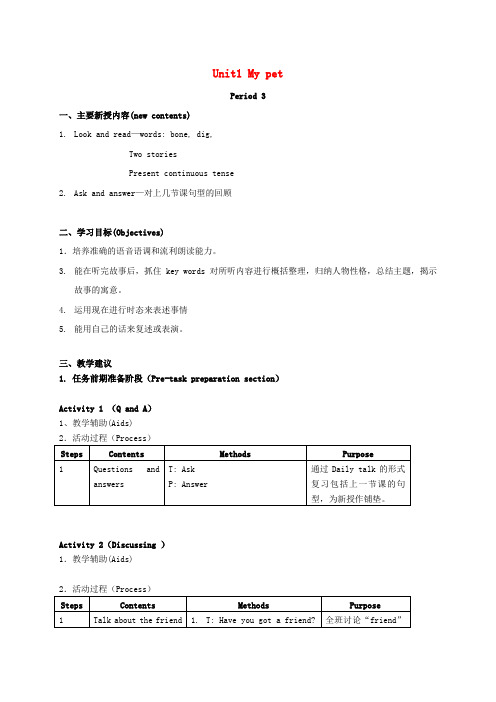
Unit1 My petPeriod 3一、主要新授内容(new contents)1.Look and read—words: bone, dig,Two storiesPresent continuous tense2.Ask and answer—对上几节课句型的回顾二、学习目标(Objectives)1.培养准确的语音语调和流利朗读能力。
3.能在听完故事后,抓住key words对所听内容进行概括整理,归纳人物性格,总结主题,揭示故事的寓意。
4.运用现在进行时态来表述事情5.能用自己的话来复述或表演。
三、教学建议1. 任务前期准备阶段(Pre-task preparation section)Activity 1 (Q and A)1、教学辅助(Aids)Activity 2(Discussing )1.教学辅助(Aids)2、任务中期实施阶段(While-task procedure section)Activity 1 (Repeat ion )1、教学辅助(Aids)录音机Activity 2 (Complete the story )1. 教学辅助(Aids)练习纸录音机Activity 3 (Learn the new word---Story 2 )1、教学辅助(Aids)图片录音机Activity 4 (Make the ending )1、教学辅助(Aids)图片录音机3、任务后期完成阶段(Post-task activity section)Activity 1(Roll play )1、教学辅助(Aids)头饰等表演用具2.活动过程(Process)可事先做好头饰,学生分组表演,允许学生适当丰富故事内容。
Activity 2(Picture talk )1.教学辅助(Aids)图片或一段有关动画短片。
牛津上海版四下Unit2Mytoysword教案
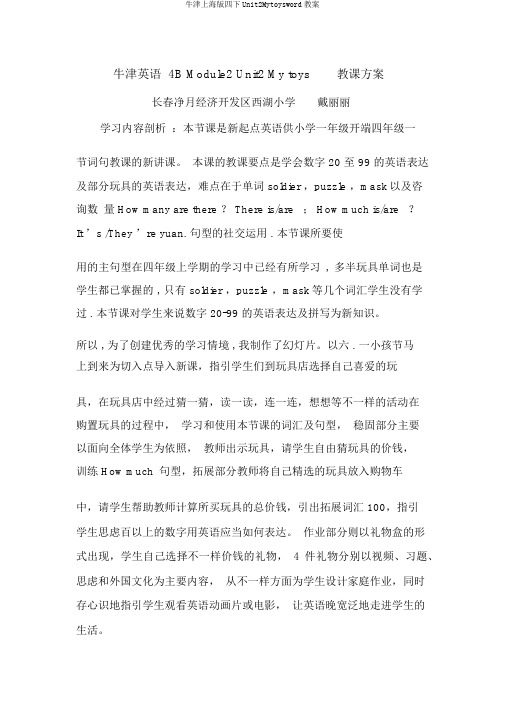
牛津英语 4B Module2 Unit2 My toys教课方案长春净月经济开发区西湖小学戴丽丽学习内容剖析:本节课是新起点英语供小学一年级开端四年级一节词句教课的新讲课。
本课的教课要点是学会数字 20 至 99 的英语表达及部分玩具的英语表达,难点在于单词 soldier ,puzzle ,mask以及咨询数量 How many are there ? There is/are ; How much is/are ?It ’s /They ’re yuan. 句型的社交运用 . 本节课所要使用的主句型在四年级上学期的学习中已经有所学习, 多半玩具单词也是学生都已掌握的 , 只有 soldier ,puzzle ,mask等几个词汇学生没有学过 . 本节课对学生来说数字 20-99 的英语表达及拼写为新知识。
所以 , 为了创建优秀的学习情境 , 我制作了幻灯片。
以六 . 一小孩节马上到来为切入点导入新课,指引学生们到玩具店选择自己喜爱的玩具,在玩具店中经过猜一猜,读一读,连一连,想想等不一样的活动在购置玩具的过程中,学习和使用本节课的词汇及句型,稳固部分主要以面向全体学生为依照,教师出示玩具,请学生自由猜玩具的价钱,训练 How much句型,拓展部分教师将自己精选的玩具放入购物车中,请学生帮助教师计算所买玩具的总价钱,引出拓展词汇 100,指引学生思虑百以上的数字用英语应当如何表达。
作业部分则以礼物盒的形式出现,学生自己选择不一样价钱的礼物,4 件礼物分别以视频、习题、思虑和外国文化为主要内容,从不一样方面为学生设计家庭作业,同时存心识地指引学生观看英语动画片或电影,让英语晚宽泛地走进学生的生活。
学习者剖析:四年级的学生正处于小学的中年级阶段,他们对四周的事物充满了无尽的好奇心和激烈的求知欲。
开朗好动,盼望用自己的眼睛去发现,探究和学习身旁的事物。
关于英语的学习也是摩拳擦掌的。
按照这样的小孩英语学习规律以及心理生剪发展的需求,本节课主要以小学生的生活经验和认知水平为基本出发点,寓教于乐,寓学于做。
牛津上海版(试用本)四年级下册英语Module 2 Unit 2 Cute animals第三课时教学设计
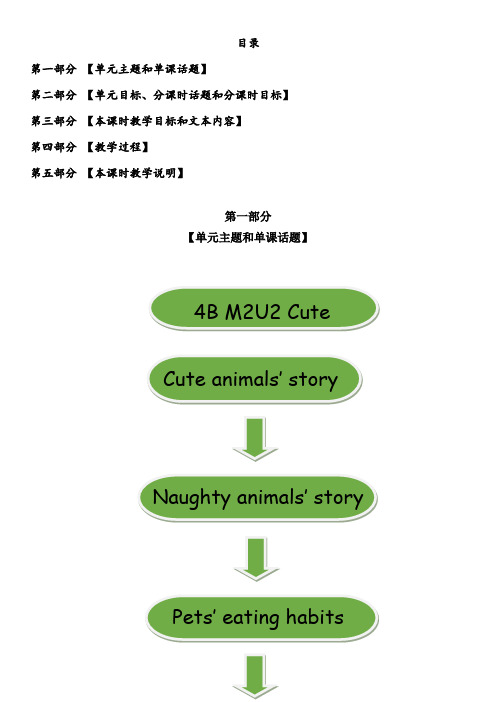
目录第一部分【单元主题和单课话题】第二部分【单元目标、分课时话题和分课时目标】第三部分【本课时教学目标和文本内容】第四部分【教学过程】第五部分【本课时教学说明】第一部分【单元主题和单课话题】第二部分【单元教学目标】知识与技能1.在语境中学习、理解并运用词汇:tortoise、parrot、bone、cat food、dog food、fish、cute等。
2.在语境中学习并运用What does ...(do)/...(does)...句型来询问动物吃的食物并做相应回答。
What does she eat? She eats fish.3.知晓元音字母o及字母组合oe, oa的发音, 在单词中准确朗读、掌握字母的发音并积累相关的单词。
过程与方法1. 学生能够熟练运用核心词汇,介绍动物的食性。
2. 学生在四个分课时的语境中,能熟练地运用-wh特殊疑问句询问动物吃的食物并做出相应回答。
3. 学生能够根据所学内容给于自己或他人对于喂养宠物的合理建议,并能够与同伴交流。
4. 学生能够理解故事内容,并完整表达,热情演绎。
情感态度价值观通过本单元四个课时的学习,学生通过了解它们的食性,关注身边的动物,产生对小动物的关爱之情。
【分课时教学目标】第三部分【本课时(第三课时)教学目标】知识与技能1. 在Pet Club的情境中,学习,理解并运用词汇:tortoise/ parrot/bone/dog food/ sunflower seeds/shrimp等。
2. 在Pet Club的情境中,运用句型What does a ... eat? / It eats ... / I feed it ...询问动物的食性。
3. 在Pet Club情境中,运用已知词汇,句型描述宠物的食性并给出合理的喂养建议。
4. 知晓元音字母o及字母组合oe, oa的发音, 在单词中准确朗读、掌握字母的发音并积累相关的单词。
过程与方法学生在Pet Club的情境中,运用任务驱动策略,学习并了解他人饲养宠物的需求。
牛津沪教四下Module 2《Unit 1 My pet》(第二课时)word教案
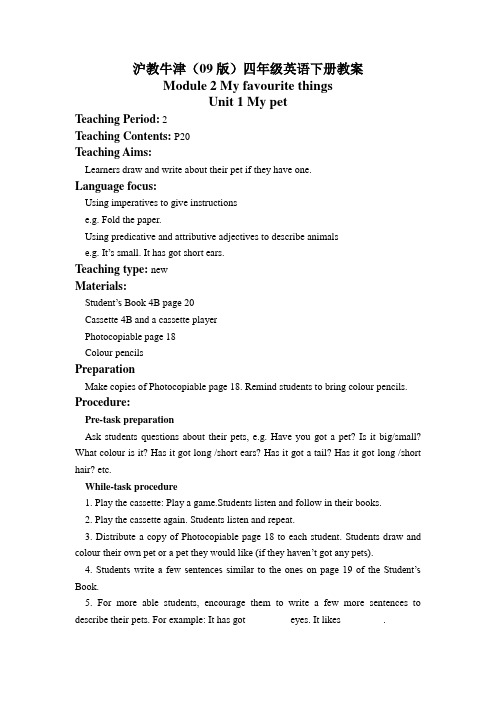
沪教牛津(09版)四年级英语下册教案Module 2 My favourite thingsUnit 1 My petTeaching Period: 2Teaching Contents: P20Teaching Aims:Learners draw and write about their pet if they have one.Language focus:Using imperatives to give instructionse.g. Fold the paper.Using predicative and attributive adjectives to describe animalse.g. It’s small. It has got short ears.Teaching type: newMaterials:Student’s Book 4B page 20Cassette 4B and a cassette playerPhotocopiable page 18Colour pencilsPreparationMake copies of Photocopiable page 18. Remind students to bring colour pencils. Procedure:Pre-task preparationAsk students questions about their pets, e.g. Have you got a pet? Is it big/small? What colour is it? Has it got long /short ears? Has it got a tail? Has it got long /short hair? etc.While-task procedure1. Play the cassette: Play a game.Students listen and follow in their books.2. Play the cassette again. Students listen and repeat.3. Distribute a copy of Photocopiable page 18 to each student. Students draw and colour their own pet or a pet they would like (if they haven’t got any pets).4. Students write a few sentences similar to the ones on page 19 of the Student’s Book.5. For more able students, encourage them to write a few more sentences to describe their pets. For example: It has got ________ eyes. It likes ________.6. Remind students to fold the paper in the same way as shown in the Student’s Book.7. Divide students into pairs or groups. Students take turns to read their classmates’ work and make guess of what pets they have got.8. Members of a group put their work together and form a pet book. Encourage students to design and make a cover for their book.学生小组活动进行介绍或者写写自己的宠物。
- 1、下载文档前请自行甄别文档内容的完整性,平台不提供额外的编辑、内容补充、找答案等附加服务。
- 2、"仅部分预览"的文档,不可在线预览部分如存在完整性等问题,可反馈申请退款(可完整预览的文档不适用该条件!)。
- 3、如文档侵犯您的权益,请联系客服反馈,我们会尽快为您处理(人工客服工作时间:9:00-18:30)。
2016-03-15 4BM2U2
Module2 My favourite things
U2 Cute animals
I. 词汇
1. 核心词汇/词组
bone cat/dog food fish parrot tortoise cute
basket mouse mice goat toast toe boat
2. 其他
eat smell shake fall sleep catch add
hungry tired angry sad dirty but so
cute animals how about…fall down wake up jump off go back to take … to teach sb. how to do …play with
II. 语法
1. fish用作可数名词指“鱼的条数”时单数和复数形式相同(two fish两条鱼),指“鱼的种类”时复数形式才为fishes(two fishes两种鱼);fish用作不可数名词时无复数形式,应作“鱼肉”解(Help yourself to some fish.随便吃些鱼.)
food “食物,两市,饲料”,为不可数名词;foods “各类食物,货物”,为集合名词。
2. like,have,smell
(1)及物动词like的基本用法:
a. like+可数名词复数/不可数名词。
如:
He likes bones. He likes meat too.
b. like+限定词+名词。
如:
She likes the meat. She likes this parrot. She doesn’t like these fishes.
Does she like your pet?
c. like+动名词doing,意为“喜欢做……”如:
Does Alice like playing badminton?
d. like+动词不定式to do,意为“喜欢去做……”如:
I would like to play table tennis.
e. like+宾格
I like it. He likes them.
(2)行为动词have
a. “(拥)有”,I have it.
b. “吃,喝”,have breakfast, have some tea
c. “上(课)”,have a swimming class, have a lesson
d. “做,进行”,have a try, have a party, have a picnic
(3)smell为半联系动词,后接形容词作表语。
如:It smells nice.
类似的词还有look,It looks great.
表语:说明主语的状态、性质、等.可为形容词、副词、名词、代词、不定式、分词.当联系动词不是be,而其后是名词和代词时,多表达‘转变为’之意,注意与动宾关系的区别.
感官动词多可用作联系动词:look well/面色好,sound nice/听起来不错,feel good/感觉好,smell bad/难闻
3. 词义比较
cute指小孩,动物可爱的,指东西小巧玲珑的,指成年人性感的
lovely可爱点,令人愉快的,美好的
4. but,“但是”,表示转折,是前后的词、短语和句子有相对立或对照的关系,如:
The mouse is happy, but the cat is angry.
so,“因此”,表示因果,使前后的句子有因果关系,如:
The mouse is hungry, so he eats the food.
-What food does a cat like?
-It likes fish.
-What does he want?
-He wants a pair of gloves.。
